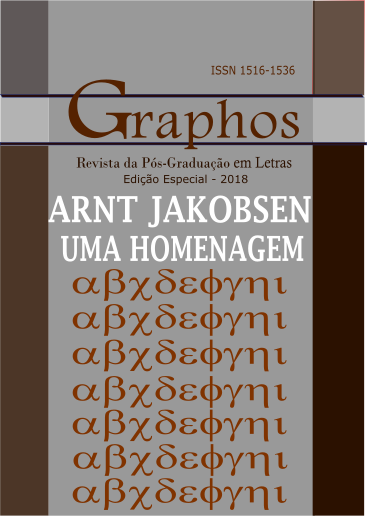O desenvolvimento e o estado atual da pesquisa do processo tradutório
Mots-clés :
Pesquisa do processo tradutório, Rastreamento ocular, Registro de acionamentos de teclas e mouse, Abordagem multimetodológicaRésumé
O interesse pelos estudos da tradução orientados para o processo tem sido ativo nos últimos mais de cinquenta anos. Estudos processuais da tradução (em inglês, translation process research, ou TPR) é o nome que temos utilizado para nos referir a uma abordagem especial, de natureza descritiva, empírica e experimental, dos estudos da tradução que se baseia, mediante o suporte tecnológico, na observação estrita do (micro)comportamento tradutório. Basicamente, a pesquisa do processo tradutório faz uso de programas de key logging, que registram, em tempo real, os acionamentos de teclas e mouse pelo tradutor, e de rastreadores oculares (eye trackers), que registram os movimentos oculares do tradutor sobre uma tela que exibe o texto-fonte e a tradução emergente. Esse método de pesquisa foi desenvolvido como meio de qualificar e reforçar as hipóteses sobre o processo tradutório aventadas com base em relatos verbais, uma vez que fornece dados adicionais, distintos e quantitativos acerca dos mesmos eventos, a partir dos quais podem ser realizadas análises e interpretações complementares. Com esse método, vários processos podem ser diretamente observados em diferentes níveis de refinamento e comparados com aspectos relatados acerca dos processos mentais, os quais permanecem inacessíveis à observação externa. Quais processos mentais subjazem o (micro)comportamento mensurável é algo passível apenas de inferência. A captura de toda a complexidade da tradução claramente requer uma abordagem multimetodológica, e os estudos da tradução devem estar abertos a estender sua curiosidade para além de si próprios, buscando suporte em áreas como a psicologia cognitiva, a psicolinguística, a neurolinguística e a neurociência, as quais também têm ativo interesse pelo que acontece dentro das nossas cabeças.
Téléchargements
Références
ALVES, F. Triangulating translation: perspectives in process oriented research. Amsterdã/Filadélfia: John Benjamins, 2003.
ALVSTAD, C.; HILD, A.; TISELIUS E. Methods and strategies of process research: integrative approaches in translation studies. Amsterdã/Filadélfia: John Benjamins, 2011.
BOWLES, M. The think-aloud controversy in second-language research. Nova York/Londres: Routledge, 2010.
BUTTERWORTH, B. Evidence from pauses in speech. In: _____. Language production: speech and talk. Londres: Academic Press, 1980. p. 155-176.
CARL, M. Triangulating product and process data: quantifying alignment units with keystroke data. In: MEES, I. M.; ALVES, F.; GÖPFERICH, S. Methodology, technology and innovation in translation process research. Copenhagen: Samfundslitteratur, 2009. p. 225- 247.
CARL, M. Patterns of shallow text production in translation. In: SHARP, B.; ZOCK, M.;
CARL, M.; JAKOBSEN, A. L. Human-machine interaction in translation: proceedings of the 8th International NLPCS Workshop. Frederiksberg: Samfundslitteratur, 2011. p. 143-151.
CARL, M.; DRAGSTED, B. Inside the monitor model: processes of default and challenged translation production. Translation: Corpora, Computation, Cognition, v. 2, n. 1, p. 127-145, 2012.
CHESTERMAN, A. Readings in translation theory. Helsinki: Finn Lectura, 1989.
DANKS, J. S.; SHREVE, G. M.; FOUNTAIN, S. B.; MCBEATH, M. K. (Ed.). Cognitive processes in translation and interpreting. Londres: Sage Publications, 1997.
DE BRUIN, A.; ROELOFS, A.; DIJKSTRA, T.; FITZPATRICK, I. Domain-general inhibition areas of the brain are involved in language switching: fMRI evidence from trilingual speakers. NeuroImage, v. 90, p. 348-359, 2014.
DRAGSTED, B. Coordination of reading and writing processes in translation: an eye on uncharted territory. In: SHREVE, G. M.; ANGELONE, E. (Ed.). Translation and cognition. Amsterdã/Filadélfia: John Benjamins, 2010. p. 41-62
DRAGSTED, B.; CARL, M. Towards a classification of translation styles based on eyetracking and key-logging data. Journal of Writing Research, v. 5, n. 1, p. 133-158, 2013.
ERICSSON, K. A.; SIMON, H. A. Verbal reports as data. Psychological Review, v. 87, p. 215-251, 1980.
ERICSSON, K. A.; SIMON, H. A. Protocol analysis: verbal reports as data. Cambridge, MA:
MIT Press, 1984 (ed. rev. 1993).
ERICSSON, K. A.; CHARNESS, N.; FELTOVICH, P. J. (Ed.). The Cambridge handbook of expertise and expert performance. Cambridge: Cambridge University Press, 2013.
FLOWER, L.; HAYES. J. R. A cognitive process theory of writing. College Composition and Communication, v. 32, n. 4: p. 365-387, 1981.
GERLO, P. Identifying the unit of analysis in translation: some uses of think-aloud protocol data. In: FÆRCH, C.; KASPER, G. (Ed.). Introspection in second language research. Filadélfia: Multilingual Matters, 1987. p. 135-158.
GOLDMAN-EISLER, F. Pauses, clauses, sentences. Language and Speech, v. 15, p. 103-113, 1972.
HOLMES, J. S. The name and nature of translation studies (1972). In: VENUTI, L. (Ed.). The translation studies reader. Londres/Nova York: Routledge, 2000. p. 172-185. HÖNIG, H.; KUSSMAUL, P. Strategie der Übersetzung. Tübingen: Narr, 1982.
IMMONEN, S. Pauses in translation versus monolingual text production. Target, v. 18, n. 2, p. 313-336, 2006.Inputlog. Disponível em: <http://www.inputlog.net/>. Acesso em: 29 maio 2014.
IVIR, V. Formal correspondence vs. translation equivalence revisited. Poetics Today, v. 2, n. 4, p. 51-59, 1981.
JAKOBSEN, A. L. Effects of think aloud on translation speed, revision, and segmentation. In:
ALVES, F. (Ed.). Triangulating translation: perspectives in process oriented research. Amsterdã/Filadélfia: John Benjamins, 2003.
JAKOBSEN, A. L. Investigating translators’ processing knowledge. In: DAM, H. V.;
ENGBERG, J.; GERZYMISCH-ARBOGAST, H. (Ed.). Knowledge systems and translation. Berlim/Nova York: Mouton de Gruyter, 2005a. p. 69-95.
JAKOBSEN, A. L. Instances of peak performance in translation. Lebende Sprachen, v. 50, n. 3, p. 111-116, 2005b.
JAKOBSEN, A. L. Tracking translators’ keystrokes and eye movements with Translog. In:
ALVSTAD, C.; HILD, A.; TISELIUS, E. (Ed.). Methods and strategies of process research: integrative approaches in translation studies. Amsterdã/Filadélfia: John Benjamins, 2011. p. 37-55.
JAKOBSEN, A. L.; JENSEN, K. T. H. Eye movement behaviour across four different types of reading task. In: GÖPFERICH, S.; MEES, I. M.; JAKOBSEN, A. L. Looking at eyes: eyetracking studies of reading and translation processing. Copenhagen: Samfundslitteratur, 2008. p. 103-124.
JUST, M. A. CARPENTER P. A. A theory of reading: from eye fixations to comprehension. Psychological Review, v. 87, p. 329-354, 1980. JÄÄSKELÄINEN, R. Think-aloud protocol studies into translation: an annotated bibliography. Target, v. 14, n. 1, p. 107-136, 2002.
KRINGS, H. P. Was in den Köpfen von Übersetzern vorgeht. Narr: Tübingen, 1986.
KRINGS, H. P. Texte reparieren: empirische Untersuchungen zum Prozeβ der Nachredaktion von Maschinenübersetzungen (Habilitationsschrift, 1995). Trad. para o inglês de Geoffrey S. Koby, Gregory M. Shreve, Katja Mischerikow e Sarah Litzer. Repairing texts: empirical investigations of machine translation post-editing processes. Kent/Ohio/Londres: Kent State University Press, 2001.
KUSSMAUL, P. Creativity in the translation process: empirical approaches. In: VAN
LEUVEN-ZWART, K.; NAAIJKENS, T. (Ed.). Translation studies: The state of the art. Proceedings of the First James S Holmes Symposium on Translation Studies. Amsterdã: Rodopi, 1991. p. 91-101.
KUSSMAUL, P. Kreatives Übersetzen. Tübingen: Stauffenburg, 2000.
KUSSMAUL, P. Übersetzen – nicht leicht gemacht. Berlim: Saxa, 2009.
LEIJTEN, M.; VAN WAES, L. Inputlog: new perspectives on the logging of on-line writing. In: SULLIVAN, K. P.; LINDGREN, E. (Ed.). Computer key-stroke logging and writing: methods and applications. Oxford: Elsevier, 2006. p. 73-94. LÖRSCHER, W. Translation performance, translation process, and translation strategies: a psycholinguistic investigation. Tübingen: Narr, 1991.
MESS, I. M.; ALVES, F.; GÖPFERICH, S. (Ed.). Methodology, technology and innovation in translation process research. Copenhagen: Samfundslitteratur, 2009.
NORD, C. Text analysis in translation: theory, methodology and didactic application of a model for translation-oriented text analysis. 2. ed. rev. Amsterdã/Nova York: Rodopi, 2005.
PICKERING, M. J.; GARROD, S. An integrated theory of language production and comprehension. Behavioral and Brain Sciences, v. 36, n. 4, p. 329-347, 2013.
RADACH, R.; KENNEDY, A.; RAYNER, K. Eye movements and information processing during reading. Hove: Psychology Press, 2004.
RAYNER, K. Eye movements in reading and information processing: 20 years of research. Psychological Bulletin, v.124, n. 3, p. 372-422, 1998.
RAYNER, K.; POLLATSEK, A. The psychology of reading. Englewood Cliffs, N.J.: Prentice Hall, 1989.
REISS, K. Möglichkeiten und Grenzen der Übersetzungskritik. München: Hueber, 1971.
REISS, K. Texttyp und Übersetzungsmethode: der operative Text. Kronberg im Taunus: Scriptor, 1976.
REISS, K.; VERMEER, H. J. Grundlegung einer allgemeinen Translationstheorie. Tübingen: Niemeyer,1984.
SCHILPEROORD, J. It’s about time: temporal aspects of cognitive processes in text production. Amsterdã: Rodopi, 1996.
SCHAEFFER, M.; CARL, M. Measuring the cognitive effort of literal translation processes. In: GERMANN, U.; CARL, M.; KOEHN, P.; SANCHIS-TRILLES, G.; CASACUBERTA, F.; HILL, R.; O’BRIEN, S. (Ed.). Proceedings of the Workshop on Humans and Computerassisted Translation (HaCaT). Stroudsburg, PA: Association for Computational Linguistics, 2004. p. 29-37 SÉGUINOT, C. The translation process: an experimental study. In: _____. (Ed.). The translation process. Nova York: H. G. Publications, 1989. p. 21-53.
SHARP, B.; ZOCK, M.; CARL, M.; JAKOBSEN, A. L. (Ed.). Human-machine interaction in translation: proceedings of the 8th International NLPCS Workshop. Frederiksberg: Samfundslitteratur, 2011.
SHREVE, G.; ANGELONE E. (Ed.). Translation and cognition. Amsterdã/Filadélfia: John Benjamins, 2010.
STRÖMQVIST, S.; KARLSSON, H. ScriptLog for Windows. User’s manual. Technical report. University of Lund: Department of Linguistics, and University College of Stavanger: Centre for Reading Research, 2002.
SULLIVAN, K. P. H.; LINDGREN, E. Computer key-stroke logging and writing: Methods and Applications. Oxford: Elsevier, 2006.
TIRKKONEN-CONDIT, S. The Monitor model revisited: evidence from process research. Meta, v. 50, n. 2, p. 405-414, 2005.
TOURY, G. Descriptive Translation Studies and beyond. Amsterdã/Filadélfia: John Benjamins, 1995.
TOURY, G. Descriptive Translation Studies — and beyond. Revised edition. Amsterdã/Filadélfia: John Benjamins, 2012.Translog. Disponível em: <http://translog.dk>. Acesso em: 29 maio 2014.
VENUTI, L. The translation studies reader. Londres/Nova York: Routledge, 2000.







